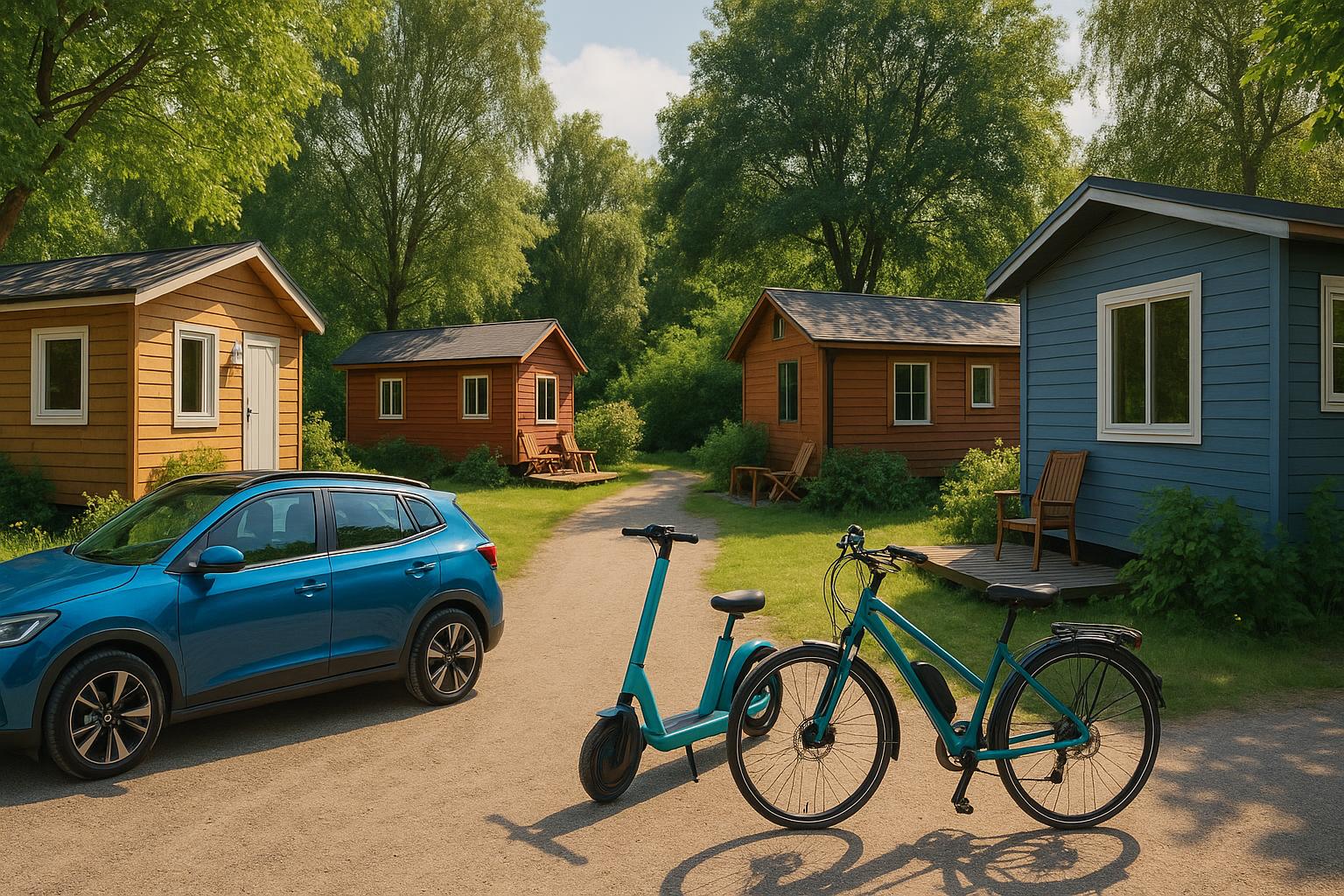
Shared Mobility in Tiny Home Communities: A New Era of Sustainable Living in Canada
Estimated reading time: 7 minutes
Key Takeaways
- Shared mobility integrates innovative transportation options with compact housing solutions.
- Tiny home communities offer affordable living, energy efficiency, and a close-knit social fabric.
- The blend of car-sharing, bike-sharing and enhanced transit links reduces emissions and urban sprawl.
- Real-life examples, such as the “12 Neighbours Community” in Fredericton, highlight tangible benefits.
- Future success hinges on smart policy, infrastructure investment, and strong community engagement.
Table of contents
Introduction: Shared Mobility in Tiny Home Community Solutions for Canada
Shared mobility in tiny home communities is emerging as a powerful answer to Canada’s urgent needs—housing affordability, lower carbon emissions, and innovative urban living. In simple terms, shared mobility covers convenient transportation options like car-sharing, bike-sharing, and robust public transit connections.
A tiny home community is a group of compact, self-contained dwellings that encourage minimalist lifestyles and foster strong social bonds. By 2025, the pairing of shared mobility and tiny home communities is gaining traction across Canada, as cities confront record-high housing costs alongside environmental challenges.
This blog post dives deep into how these two innovative approaches complement each other, featuring a detailed case study, real-world benefits, practical implementation advice, and a forward-looking vision for sustainable urban development. For more insights, check out Innovative Living Options in Canada, Tiny House News Canada, Affordable Eco Living in Tiny Home Communities, Tiny Home Living Guide, and Financing Tiny Home Villages in Canada.
Understanding Shared Mobility in Tiny Home Communities
What is Shared Mobility?
Shared mobility involves using transportation modes collectively rather than owning individual vehicles. This includes:
- Car-sharing: Utilizing shared electric vehicles or local programs like the Modo service in British Columbia.
- Bike-sharing: Accessing bicycles from communal stations for short-distance travel.
- Enhanced Transit Links: Strengthening bus and train connections to serve communities where car ownership is low.
With benefits such as reduced greenhouse gas emissions, lower personal transportation costs, and increased urban flexibility, shared mobility stands as a cornerstone of sustainable community design. Learn more from Innovative Living Options in Canada, Community Led Tiny Home Development, and Car-Free ADU Sustainable Living in Canada.
What is a Tiny Home Community?
A tiny home community consists of ultra-compact living spaces—often less than 40 square metres—designed to reduce housing costs and resource consumption. These dwellings, sometimes known as ADUs (accessory dwelling units), empower residents to:
- Cut housing expenses by sharing land and communal resources.
- Minimize energy use for heating, cooling, and lighting.
- Forge stronger social ties through shared spaces and community activities.
For a deeper dive into this lifestyle, visit Tiny House News Canada, Affordable Eco Living in Tiny Home Communities, and the Tiny Home Living Guide.
Shared Mobility and Tiny Home Communities: Natural Partners
Integrating shared mobility into tiny home communities is a natural fit. With limited space for individual parking and more room available for green spaces, communities can:
- Rely on communal vehicles and bikes instead of personal cars.
- Repurpose land typically used for driveways into parks and gardens.
- Strengthen civic bonds by promoting resource sharing and collaborative living.
See how this synergy works in practice at Tiny Home Villages Community Benefits, Rise of Tiny Homes in Canada, Mini Home Compact Living Guide, and Tiny Home Community Startups in Canada.
Sustainability Benefits: Shared Mobility and Tiny Home Community Integration
Environmental Benefits
- Less Traffic, Fewer Emissions
- Car-sharing and bike-sharing decrease the number of vehicles on the road.
- Electric vehicles and bike programs bring down harmful greenhouse gases.
- Energy Efficiency
- Compact homes require less energy for heating and cooling.
- Smaller Carbon Footprint
- Shared trips and sustainable design practices reduce the overall environmental impact.
These environmental gains align with Canada’s climate targets. Explore more details via Innovative Living Options in Canada, Tiny Home Villages Community Benefits, and Tiny Sustainable Living Homes.
Land Use Benefits
- Denser Neighborhoods
- Tiny home clusters promote pedestrian-friendly environments and vibrant communities.
- More Green Space
- Areas once reserved for parking are reimagined as community gardens and parks.
- Reduced Urban Sprawl
- Smaller living spaces allow for more efficient land use in urban planning.
For additional insight, visit Rise of Tiny Homes in Canada and Urban Infill Tiny Homes & ADU.
Social Benefits
- Improved Accessibility
- Shared mobility ensures everyone, including non-car owners, can travel easily.
- Enhanced Social Connections
- Communal spaces and activities nurture a sense of security and belonging.
- Lower Living Costs
- Cost savings on both housing and transportation free up resources for other needs.
Discover more on how communities benefit at Innovative Living Options in Canada, Tiny Home Villages Community Benefits, and Multi-Generational Living in Tiny Homes.
Case Study: Shared Mobility in a Canadian Tiny Home Community
Introducing the “12 Neighbours Community”
Located in Fredericton, New Brunswick, the “12 Neighbours Community” exemplifies how shared mobility and tiny home design converge to address housing challenges. This community features dozens of tiny homes designed for residents facing affordability challenges and individuals transitioning out of homelessness.
Shared Mobility Features
- Communal Vehicles: Residents share electric cars for errands, appointments, and daily commutes.
- Bike-Rack Stations: A fleet of shared bikes is available for zero-emission travel.
- Transit Integration: Strategic planning connects the community with city bus routes, facilitating access to work and social opportunities.
Outcomes
- Reduced Emissions: Lower vehicle usage cuts pollution and conserves energy.
- Resident Satisfaction: Affordable mobility options reduce stress and boost daily activity.
- Stronger Community Ties: Sharing transportation not only saves money but also builds lasting neighborly bonds.
- Economic Opportunities: Reliable transit increases employment and volunteering prospects.
- Cross-Sector Partnerships: Collaboration among non-profits, city departments, and tech companies ensures sustainable management of shared mobility.
For further details on community initiatives, visit Tiny Home Communities in Canada and Tiny Home Community Startups in Canada.
Practical Considerations: Implementing Shared Mobility in Tiny Home Communities
Building the Infrastructure
- Bike Lanes and Sidewalks: Creating safe cycling paths and walkways to support low-carbon transit.
- Car-Share Parking: Setting aside designated parking for communal electric vehicles.
- Transit Access: Ensuring tiny home clusters are within easy reach of bus or train stops.
These foundational elements are crucial for a sustainable, low-car community. Additional insights can be found at Tiny House News Canada, Rise of Tiny Homes in Canada, and Urban Infill Tiny Homes & ADU.
Policy and Regulation
- Zoning Reform: Updating bylaws to permit high-density, small-scale housing such as tiny homes and ADUs.
- Flexible Policies: Encouraging mixed-use developments and shared parking options to complement modern urban needs.
Progressive policies are key to overcoming traditional obstacles, as demonstrated by examples in cities like Edmonton. Learn more from Tiny House News Canada and Ontario ADU Zoning Guide.
Financing, Technology, and Community Engagement
- Securing Funding: Leverage city grants, provincial support, or private partnerships for infrastructure investments.
- Smart Booking Systems: Utilize mobile apps or kiosks to streamline the reservation of shared vehicles and bikes.
- Resident Outreach: Host workshops and informational sessions to ensure community needs are met and voices are heard.
For further strategies, read about Innovative Living Options in Canada and Tiny Home Community Workshops in Canada.
Best Practices and Challenges
- Collaborative Planning: Engage municipal officials, non-profits, and local residents in planning and decision-making.
- Clear Communication: Set realistic expectations regarding costs and benefits to reduce misunderstandings.
- Long-Term Maintenance: Implement sustainable plans for maintenance and operational adjustments as community needs evolve.
- Regulatory Hurdles: Anticipate delays and explore flexible alternatives when facing local resistance.
Looking Ahead: The Future of Sustainable Neighbourhoods in Canada by 2025
The Growth of Shared Mobility and Tiny Home Community Models
Over the coming years, Canada is poised to embrace a surge in shared mobility projects integrated within tiny home communities. Driving factors include:
- Rising Housing Demand: Increasing numbers of Canadians are seeking affordable, flexible, and eco-friendly living arrangements.
- City Commitments: Municipal governments are prioritizing sustainability strategies that incorporate innovative transport and housing solutions.
- Wider Social Acceptance: As urban land becomes scarcer, tiny homes and ADUs continue to gain popularity.
More information can be found via Innovative Living Options in Canada, Tiny Home Villages Community Benefits, Rise of Tiny Homes in Canada, and Affordable Eco Living in Tiny Home Communities.
Next Steps: Partnerships and Action
Collaboration is key. Municipalities, tech startups, and housing advocates must join forces to create integrated communities that combine tiny homes with smart mobility solutions. A community-driven approach will pave the way for neighborhoods that are sustainable, connected, and future-ready.
Now is the time for community leaders and stakeholders to take action—champion shared mobility and tiny home solutions to help Canada meet its climate and housing goals.
Conclusion: The Path Forward for Shared Mobility in Canadian Tiny Home Communities
Integrating shared mobility into tiny home communities is nothing short of transformative for urban and rural Canada alike. By merging innovative transport—like car-sharing and bike-sharing—with compact, energy-efficient housing, communities can effectively reduce greenhouse gas emissions, lower living costs, and foster strong neighborly bonds.
As demonstrated by the Fredericton case study, these models not only provide affordable, sustainable living but also spark creative collaborations among non-profits, municipal Bodies, and tech innovators. Embracing these practices is essential for steering Canada toward a greener, more connected future.
Ready to drive change? Explore detailed case studies, support local policies, and join the movement towards shared, sustainable living.
Learn more at Innovative Living Options in Canada, Tiny Home Villages Community Benefits, Tiny Home Communities in Canada, Rise of Tiny Homes in Canada, and Affordable Eco Living in Tiny Home Communities.
Frequently Asked Questions
What exactly is shared mobility?
Shared mobility refers to transportation solutions such as car-sharing, bike-sharing, and improved public transit that allow communities to reduce individual car ownership and lower emissions.
How do tiny home communities contribute to sustainability?
Tiny home communities feature compact living spaces that require less energy for heating and cooling, reduce land consumption, and foster strong social bonds—all of which contribute to a lower environmental footprint.
What are the main benefits of combining shared mobility with tiny home communities?
The integration leads to reduced traffic and emissions, lower housing costs, enhanced community cohesion, and improved accessibility—all essential for creating sustainable, future-ready neighborhoods.
How can municipalities support these initiatives?
Governments can update zoning laws, invest in shared transport infrastructure, and encourage collaborative planning among residents, non-profits, and tech innovators to successfully integrate these models.
Where can I find more information about shared mobility and tiny home communities?
For further reading, visit trusted resources like Innovative Living Options in Canada, Tiny Home Villages Community Benefits, and other expert sites mentioned throughout this post.

Leave a Reply